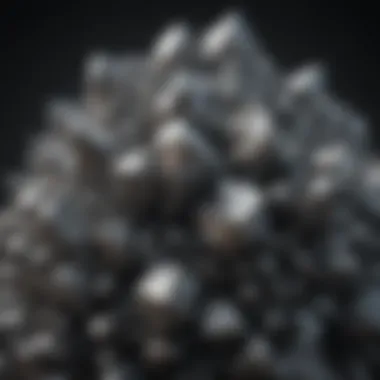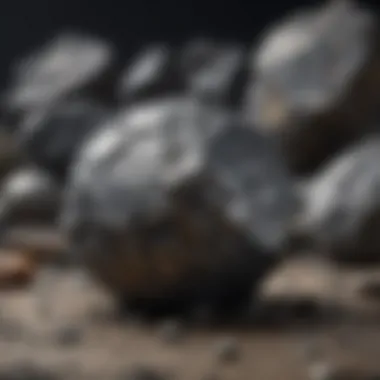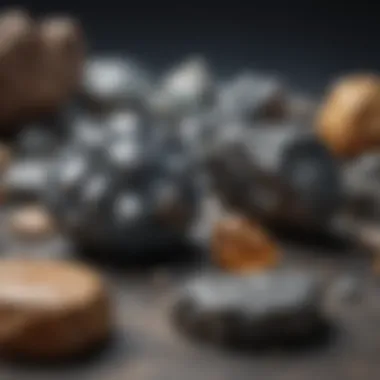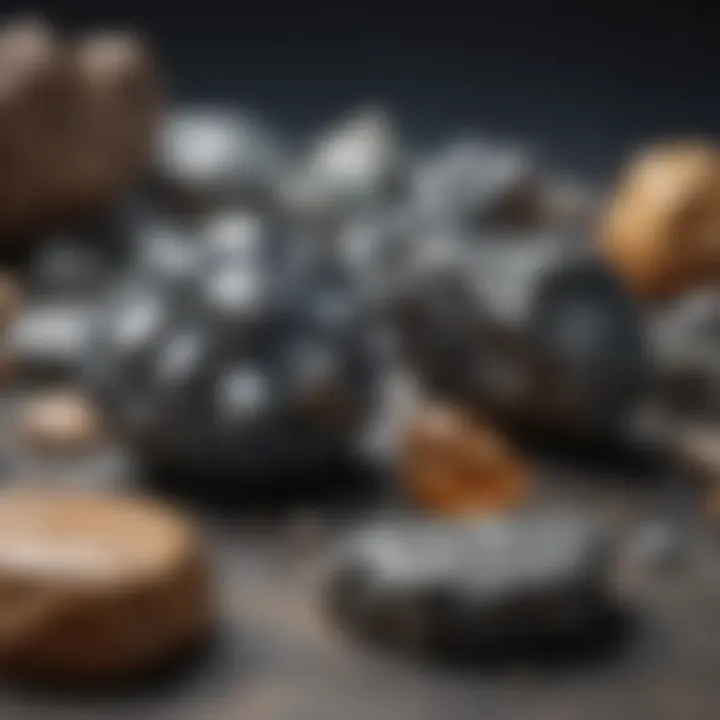Is Graphite a Mineral? Exploring Its Complex Nature


Intro
Graphite stands at a perplexing intersection of mineralogy and material science. To many, it's merely a common form of carbon, found perhaps in the pencils we use every day. Yet, when one digs deeper into its crystalline structure and unique properties, the question arises: Is graphite a true mineral? This article unpacks that intricacy, examining not only the characteristics that jockey for mineral status but also the geological formations where graphite resides. Additionally, we’ll explore the industrial importance that this seemingly ordinary material holds across diverse sectors.
History and Origins
Overview of Collectibles, Rocks, and Fossils
The fascination with graphite traces back thousands of years. Its early usage can be seen in prehistoric drawings, where ancient humans utilized the naturally occurring form of graphite to create striking images on cave walls. This indicates that humans were not only aware of its properties but also its potential utility. In the realm of collectibles, graphite holds a unique position because of its dual nature. While many rock and fossil collectors are more inclined towards vibrant minerals or ancient fossils, graphite is often overlooked, relegated to the shadows of more visually stimulating specimens.
Graphite itself begins as carbon-rich materials that undergo metamorphosis under immense pressure and heat deep within the Earth’s crust. As a collector, understanding where this substance can be found is paramount. Formations can range from sedimentary basins to high-grade metamorphic rocks. Notable occurrences can be found in places such as Canada, China, and even in the U.S. eastern regions.
Historical Significance and Cultural Impact
Graphite's significance heightened dramatically during the 16th century when it was discovered in large deposits in Borrowdale, England. This brought graphite into the limelight, showcasing its utility, particularly in the art of writing and drawing. The initial solid sticks of graphite were wrapped in string or wood, birthing the early pencil — a tool that would later dominate education and artistry.
"Graphite's versatility is akin to a chameleon; it adopts various forms and functions throughout history, showcasing the compelling relationship between nature and human innovation."
Moreover, beyond pencils, graphite's unique conductive properties paved the way for its use in emerging technologies, which only adds layers to its historical tapestry and ongoing cultural relevance. From enhancing the performance of batteries to serving as a key component in lubricants, graphite has morphed into a material integral to both everyday life and advanced applications.
Identification and Classification
Key Characteristics of Graphite
When it comes to identifying graphite, collectors should look for specific traits:
- Texture: Graphite exhibits a layered structure, having a smooth feel. Its sheets can easily slide over one another, creating a slippery sensation.
- Color: While often a dull gray or black, high-purity graphite may exhibit a more metallic sheen when polished.
- Hardness: On the Mohs scale, graphite ses at around 1-2, easily distinguishable from harder minerals.
Common Types and Variations
Graphite is not a monolithic entity; several types showcase differing characteristics that can intrigue collectors:
- Natural Flake Graphite: Often found in metamorphic rocks, this form occurs as thin, flat flakes.
- Amorphous Graphite: A more finely dispersed, powdery version, typically found in sedimentary deposits.
- Synthetic Graphite: Created through industrial processes, it is often used in specialized applications such as batteries.
- Vein Graphite: This form is considered the 'rare gem' of graphite, found in narrow veins within host rocks.
The intersection of classification and functional properties of graphite also opens an array of questions that prompt deeper thought about what constitutes a mineral.
Understanding Minerals
In any exploration of graphite, we must first venture into the world of minerals and grasp what specifically distinguishes one from another. Why is this significant? Well, grasping the definition and classification of minerals serves as the foundation stone for our understanding of graphite's nature. Think of it as setting the stage before the main act; without this groundwork, the complexities that follow may seem convoluted.
Definition of a Mineral
A mineral can typically be defined as a naturally occurring substance that is solid and stable at room temperature, with a specific chemical composition and characteristic crystal structure. Essentially, it’s not just a rock or some random chunk of earth; it needs to have those distinct qualities that set it apart from other materials located in nature. However, therein lies the quandary; substances like graphite often blur these lines, challenging our perceptions of what a mineral is.
Criteria for Mineral Classification
Minerals are classified based on several criteria. Understanding these can give greater insight into our topic of graphite. Here are the key criteria:
Natural Occurrence
The concept of natural occurrence is crucial when considering graphite. A mineral must be found in nature, in an unaltered form. Graphite naturally forms within metamorphic rocks under high-pressure conditions, offering a unique aspect to its classification. This leads us to appreciate that its sourcing from nature confirms its legitimacy as a mineral in that regard. While many might think any formed material in labs is equal, true minerals come from the earth, enriching the dialogue around graphite.
Solid State
When we mention the solid state, we are underscoring something rather vital. For something to classify as a mineral, it has to be solid at room temperature. Graphite fits this criterion perfectly. Although it is often mistaken for a mere carbon substance, its solid state is what allows its unique properties to shine through, bringing value not only in geology but also in various practical applications. That solid form houses the exceptional qualities graphite is known for, like its ability to conduct electricity yet remain an effective lubricant in mechanical applications.
Specific Chemical Composition
Specific chemical composition raises eyebrows when evaluating graphite. At its core, graphite consists entirely of carbon atoms arranged in a unique way, defining its character. This purity and distinctness shake hands with the demands of mineral classification. The downside? Many might argue that this high level of specificity narrows graphite's classification based on overly stringent rules, which can distort the overlapping nature of mineral identities.
Ordered Atomic Arrangement
Finally, an ordered atomic arrangement refers to how the atoms are structured within the material. While graphite boasts an orderly arrangement within its layered planes, its bonding nature—where carbon atoms are arranged in a hexagonal lattice—reinforces the discussions about its classification. The advantage of this arrangement is how it contributes to graphite's physical characteristics, lending to its softness and unique bonding abilities. On the flip side, this also incites questions about its status as a mineral when compared to other substances with similar properties but dissimilar structures.
The criteria for defining minerals may appear straightforward; however, exceptions like graphite question the rigidity of these classifications.


As we pierce through the layers of graphite's classification, the insights gleaned from understanding minerals provide a necessary backdrop against which further exploration unfolds. The journey towards understanding graphite's true nature isn't just about what it is but also how it navigates the intricacies of mineral classification.
Preamble to Graphite
Graphite plays a vital role in understanding the complex classification of naturally occurring materials, sparking debates among geologists and material scientists alike. As we dive into graphite, we must take stock of its distinct chemical makeup and physical characteristics within the broader context of natural resources. This section sets the stage, dissecting what makes graphite both intriguing and contentious, especially when categorized alongside traditional minerals.
Chemical Composition of Graphite
Graphite is an allotrope of carbon, composed entirely of carbon atoms arranged in a crystalline structure. The unique layering of carbon atoms is what gives graphite its notable properties. Each layer consists of hexagonally arranged carbon atoms bound together by covalent bonds, while layers themselves are held together by weaker van der Waals forces. This intricate arrangement doesn’t just make graphite functionally diverse; it raises questions regarding its classification as a mineral. Although other carbons, like diamonds, boast a different atomic organization, graphite displays a fascinating balance of strength and softness, opening conversations about how we categorize these carbonaceous forms.
Physical Properties of Graphite
Understanding graphite's physical properties enhances appreciation for its varied applications and the ongoing debates about its classification.
Color and Luster
Graphite's color varies from dark gray to black, often exhibiting a metallic luster that shows when light strikes its surface. This characteristic color arises from the way the layers reflect light—giving it a shiny, lustrous appearance. Such an aesthetic appeal is essential in art and manufacturing, as high-quality graphite can provide excellent visual aspects to final products. However, the notable color and luster indicators also expose its dual nature; while these features can be beneficial in art supplies, they might cloud its mineral legitimacy in some scientific contexts.
Hardness
In terms of hardness, graphite is regarded as relatively soft, rating around 1 to 2 on the Mohs scale. This property is pivotal when discussing its function in applications like lubricants or pencils, where it is indispensable due to its ability to slide easily against surfaces. Notably, the softer nature of graphite allows it to be used in various formulations requiring a degree of pliability, yet this may also lead critics to question whether something so soft could fit the strict definitions of a mineral. The variability in hardness invites an assessment beyond conventional materials, suggesting that texture and usability may also weigh heavily in classification discussions.
Cleavage and Fracture
Graphite exhibits perfect basal cleavage; that is, it can be split along its layers easily. This characteristic fundamental to its structure allows graphite to break into thin, flexible sheets, each retaining the same chemical composition. Such a unique feature enhances the material's practicality in various industries, from electronics to art. However, the perfect cleavage characteristic raises concerns regarding its classification—some may argue that if a material can be easily separated or altered, it may not maintain the rigid boundaries of a traditional mineral.
"Graphite's unique properties highlight the challenges of defining hard and fast categories in the natural world; just as life has its shades of gray, so too does the classification of materials like graphite."
In summary, graphite's unique chemical composition and distinct physical properties assert its significance in ongoing discussions surrounding mineral classifications. Its varied uses across multiple domains remind us of the complexity embedded within seemingly simple classifications. Each characteristic contributes to the layered conversation around what constitutes a mineral, inviting deeper exploration as we continue to unravel graphite's role in the natural and technological spheres.
Graphite: A Contested Classification
The classification of graphite remains a point of contention among geologists and material scientists alike. This divergence mainly arises from the complex characteristics that graphite exhibits, leading many to question whether it fits snugly into the conventional definitions of a mineral. Understanding this classification is crucial because it influences both academic discourse and practical applications related to graphite. The perceived mineral status of graphite can directly impact mining practices, the valuation of deposits, and even its role in various technologies.
Is Graphite a Mineral?
Arguments Supporting Mineral Status
When examining the argument that graphite is a mineral, several aspects surface, particularly its natural occurrence and distinct crystalline structure. For one, graphite is naturally found in various geological settings, from metamorphic terrains to igneous formations. This aligns with one of the key criteria for mineral classification. Moreover, the unique layered structure of graphite, where carbon atoms are arranged in hexagonally bonded sheets, divulges a clear atomic order.
One of the most beneficial characteristics backing its mineral status is the way graphite fulfills the specific chemical composition requirement. Graphite is primarily composed of carbon, which supports its classification under carbonaceous materials. This is not only beneficial to this article, but also presents a solid basis for its recognition as a mineral. While this classification simplifies some aspects of its understanding, it does bring along complications regarding the variable quality and structural forms that graphite can take.
Counterarguments and Controversies
Despite its many attributes supporting the idea that it is a mineral, strong counterarguments exist. Critically, some argue that graphite should not be classified as a mineral due to its inherent variability and the presence of synthetic forms that mimic its characteristics. This characteristic brings forth the question of authenticity in mineral status.
Moreover, the debate hinges on whether graphite's layered structure, which allows for easy cleavage along its planes, diminishes its status as a true mineral. Because it can easily be produced in a lab, detractors argue that this synthetic parallel might muddle the waters of its classification. This controversy stimulates a meaningful dialogue, challenging readers to consider deeper questions about what defines a mineral in the first place.
Comparison with Other Carbonaceous Forms
Diamond
When it comes to comparing graphite with other carbon forms, diamond often stands out. Although both graphite and diamond are allotropes of carbon, their properties are as different as night and day. Diamond’s outstanding hardness and orderly crystalline structure make it one of the hardest known materials on Earth.
This unique feature of diamond as a superlative gemstone forms a beneficial contrast to graphite. While graphite can be a crucial component in lubricants due to its softness, diamonds proudly sit atop the jewelry market and in industrial cutting applications. This comparison highlights the versatility of carbon in various forms, emphasizing how the same element can fulfill diverse roles depending on its structure and arrangement.
Carbon Nanotubes
Another alternative carbon form, carbon nanotubes, emerges in this comparison thread, offering incredible potential in technology and materials science. They exhibit remarkable strength and electrical conductivity, setting them apart from graphite's properties. Their unique tubular structure allows for applications in nanotechnology, which draws interest for electronics and composite materials.
One advantage of carbon nanotubes is their ability to be engineered at the molecular level, providing a spectrum of tailored properties. However, their production can be complex and expensive, presenting challenges in terms of scalability compared to graphite, which is more readily available. This exploration of carbon nanotubes emphasizes the nuances within carbon allotropes, shaping our understanding of their significance in various fields.
Geological Context of Graphite
Understanding the geological context of graphite is vital for several reasons. It situates graphite within the broader landscape of mineral formation and classification, highlighting the processes that contribute to its unique characteristics. This section not only discusses where graphite is found but also delves into how these deposits form and why they hold significance both economically and ecologically.
Occurrence in Nature


Graphite Deposits Worldwide
Graphite deposits are scattered across the globe, each location presenting distinct features that contribute to their overall value in the mineral world. For example, countries like China, Brazil, and Canada stand out with some of the largest deposits, making these locations hot spots for mining activities. The sheer size of these deposits indicates their importance. China, particularly, dominates the market controlling approximately two-thirds of the world’s graphite production, which allows it to influence prices and availability globally.
What makes these deposits beneficial for this article is their potential for industrial applications and geological study. They vary not only in size but also in quality, with some regions producing high-purity natural graphite while others yield amorphous varieties. This qualitative aspect is a critical factor as it impacts everything from market price to utility in specific applications, like batteries or lubricants.
Additionally, the environmental implications of these worldwide deposits cannot be overlooked. Each locale's extraction methods can lead to varying degrees of ecological disruption. Thus, understanding the geographic distribution of graphite deposits allows researchers and collectors to assess the sustainability of their sourcing methods, ensuring minimal impact on local ecosystems.
Formation Processes
The formation processes of graphite are as fascinating as the deposits themselves. Graphite generally forms under high-temperature and high-pressure conditions, specifically through metamorphism of organic matter. The transition from carbon-rich materials—like plant debris—to graphite can take millions of years, typically occurring in sedimentary basins.
This metamorphic journey is crucial because it emphasizes the natural processes involved in the genesis of graphite and why it is classified as a mineral in certain contexts. The key characteristic of formation processes is that they illustrate graphite's role in the carbon cycle, linking geological activities to life on Earth. This relationship presents a significant point of discussion, particularly when examining the environmental implications of mining and excavation.
One unique feature of graphite formation is its alignment within schist or gneiss during metamorphism, which often leads to the creation of flake graphite—an important form that is highly desired in various industrial applications. However, the energy-intensive processes used to extract and refine graphite raise concerns over carbon footprints, making the understanding of these formation processes invaluable for collectors and scientists alike.
Mining and Extraction
Graphite mining and extraction come with their own set of challenges and considerations. The methods employed often influence the environmental integrity of the associated regions. Open-pit mining and underground mining are the two primary techniques utilized, each bearing its specific advantages and disadvantages.
In terms of economic yield, open-pit mining is often more efficient for larger deposits. However, the surface disruption can lead to significant landscape alterations, affecting local wildlife and water systems. On the other hand, underground mining might minimize surface damage but demands higher operational costs and presents various safety hazards.
"The journey to understanding graphite's complexity goes beyond its mineral classification; it delves deep into the realms of sustainability and resource management."
Understanding both the geological context and the methods of extraction helps collectors and researchers to appreciate the balance between resource acquisition and ecological preservation. This dual focus makes it possible to not only engage with graphite as a mineral but to consider its implications on a more extensive ecological and economic scale.
Practical Applications of Graphite
Graphite is not just a pretty face in the mineral world; it plays a pivotal role across a myriad of practical applications. From its use in everyday items to cutting-edge technologies, understanding these applications reveals much about its value. This section dives into the industrial uses of graphite and its role in technology, providing insights particularly interesting for collectors, researchers, and anyone intrigued by this remarkable material.
Industrial Uses
Electrodes and Batteries
The use of graphite in electrodes and batteries is where this material shines brightest. Graphite can conduct electricity, which makes it a prime candidate for various applications, especially in batteries such as lithium-ion batteries, which power everything from smartphones to electric cars. The conductivity ensures efficient energy transfer, which is crucial for performance and longevity.
A key characteristic of graphite in this context is its high thermal stability. This property allows it to withstand the heat generated during charging and discharging cycles without degrading. Being a steady performer, graphite is often seen as a reliable choice.
One unique feature of graphite electrodes is their ability to be shaped into complex forms, making them useful in both small and large-scale applications. However, one disadvantage is that, as more advanced battery technologies emerge, there's ongoing discussion about how graphite’s role might shift or lessen, especially when weighed against newer materials like silicon.
Lubricants
When it comes to lubricants, graphite stands out due to its natural slipperiness. It's not uncommon to find graphite used in various applications where friction reduction is vital. Graphite lubricants can thrive in high-pressure environments, making them a go-to option for machines operating under tough conditions.
A significant advantage of graphite lubricants is their ability to function without the need for liquid environments, allowing for cleaner applications. This reduces the risk of contamination or mess, valuable for operations in clean environments. One downside, though, is that while graphite is hardy, extreme pressure can lead to degradation over time, necessitating regular reapplication.
Role in Technology
The technological implications of graphite are expansive, most notably embodied in graphene's transformative potential. Graphene, a single layer of carbon atoms, holds remarkable properties attributed to its graphite roots. Its exemplary strength, lightweight nature, and high conductivity place it at the forefront of new tech innovations.
The key characteristic of graphene that excites researchers and developers alike is its incredible strength-to-weight ratio. It’s immensely strong yet exceedingly light, making it a game-changer for everything from flexible electronics to advanced composites. This unique feature positions graphene as an alluring option for creating more efficient products across diverse sectors.
However, the challenges aren’t trivial. The process of isolating graphene from graphite can be complex and costly, often limiting widespread adoption for ordinary uses. As research progresses and methodologies improve, it's likely that we'll see a broader application of this wonder material.
"The innovation in graphite's applications reflects not just in industry but in sustainability opportunities too, turning a raw material into something uniquely impactful."
From the world of industrial uses to technological advancements, graphite presents a compelling case for its ongoing relevance. With continuous research converting its potential into reality, graphite is cementing its place in a future that blends ancient materials with modern innovation. This interconnected role speaks volumes about its broader significance in both industry and everyday life.
Graphite and Cultural Significance
Understanding the role of graphite is more than just a scientific inquiry; it digs into the very fabric of human history, creativity, and industry. Graphite has been a versatile material, finding its way into various aspects of society, from art to technology. Its unique properties have made it a cornerstone in many cultural narratives. This section will explore some of the key historical and artistic dimensions of graphite, illustrating how deeply integrated it is in cultural paradigms.
Historical Aspects of Graphite Usage
Graphite's history can be traced back several centuries, showcasing its journey from a mere geological curiosity to a vital industrial component. One of the earliest recorded uses of graphite dates back to the 16th century in England, where it was discovered in Borrowdale. This so-called 'black lead' was used initially for marking sheep, which highlights its practicality even in those early times. This simple application flourished with time, evolving into sophisticated uses in various fields.
In the late 18th and early 19th centuries, the emergence of the graphite pencil revolutionized writing and artistry. Before that, people relied on various materials, but nothing matched the smooth application and versatility that graphite provided. Artists such as Rembrandt and later Van Gogh used graphite to sketch their masterpieces. It became a symbol of artistic expression, allowing for nuances in shading and depth that other media could not achieve. The graphite pencil has thus become a fundamental tool, illustrating how this mineral crossed the line between geology and culture and cemented its status.


Graphite in Art and Industry
Art Supplies
When we consider graphite as an art supply, its contribution is undeniably pivotal. Graphite's key characteristic lies in its ability to create fine lines and delicate shading. Artists love it for its versatility and ease of use; it allows for quick adjustments, making it less daunting than other mediums. The texture of graphite leads to a range of possible outcomes, from soft sketches to intricate details, giving artists the ability to express their vision organically.
One unique feature of graphite pencils is their varying degrees of hardness, indicated by the H (hard) to B (black) scale. Artists can choose the right pencil based on the project they’re working on, offering an impressive array of creative options. However, a notable disadvantage is that while graphite can produce stunning images, it can smudge easily, potentially affecting the final artwork without careful handling. This trait makes it both a beloved and sometimes frustrating medium for artists—thoughtful practice can propel the artists' skills forward, while carelessness might lead to unintended mishaps.
Writing Instruments
Graphite has an exceptional role in the domain of writing instruments, notably the pencil. Its key characteristic here is its smooth application when put onto paper. The balance of hardness and flexibility allows for effortless writing.
As writing evolved, the graphite pencil offered a reliable solution that didn’t fade over time, unlike ink. That reliability has made it a staple in literary works and everyday tasks, further cementing its importance in education and industry alike.
Interestingly, the unique feature of the pencil lies in its erasable nature. Mistakes can be corrected, providing flexibility that has helped in learning environments. However, this trait can backfire in certain professional fields, where indelible marks are crucial. The balance between erasability and permanence remains a constant discussion among professionals, as well as between students and instructors who seek to harmonize efficiency with accuracy.
Overall, the cultural significance of graphite spans across various avenues, embodying the timeless interplay between natural materials and human creativity. In its remarkable spectrum of applications, graphite reveals not just a component of industry but a vital element of artistic expression and communication.
Environmental Considerations
The relationship between graphite and the environment holds significant weight as we delve into its mining and usage. Understanding how graphite extraction impacts local ecosystems can guide us toward more sustainable practices. The environmental implications of graphite mining cannot be understated, as they challenge both the sustainability of the industry and the health of our planet. This section examines the delicate balance between harvesting a valuable resource and safeguarding the natural world.
Sustainability in Graphite Mining
Sustainability in graphite mining is about more than just cleaner extraction methods; it's about ensuring that the resources we extract today do not compromise tomorrow's natural reserves. Mining operations can pose serious risks to the environment. Deforestation, soil erosion, and water contamination can occur if regulations aren’t closely observed. There’s often a tension between maximizing profits and preserving nature.
Benefits of sustainable practices in graphite mining often include:
- Reduced environmental impact: Eco-friendly mining techniques help lower emissions and minimize habitat destruction.
- Long-term resource availability: When companies prioritize sustainability, they ensure that graphite will be available for future generations.
- Local community health: Responsible mining often leads to fewer health risks for workers and nearby residents, as well as greater economic stability.
In many regions, efforts are being made to shift toward more sustainable practices, from reducing water usage during mining to restoring mined lands after closure. However, this transition requires not just technological advancements but also a cultural shift within the industry—a realization that environmental stewardship must outweigh short-term financial gains.
Recycling Graphite Products
Recycling graphite products is another pivotal aspect of making the use of graphite more sustainable. As industries evolve and the demand for graphite grows, so grows the importance of finding ways to reuse this material. Graphite can be recycled from various sources, including batteries, lubricants, and even old pencils. This reduces the need for fresh extraction, placing less pressure on natural reserves.
The key benefits of recycling graphite include:
- Conservation of natural resources: By reusing graphite, we preserve the existing natural deposits and reduce the environmental impact of mining.
- Energy savings: Recycling often consumes significantly less energy compared to extraction and processing new graphite, thus lowering greenhouse gas emissions.
- Economic advantages: Recycled graphite can be less expensive to produce than newly mined material, making it an attractive option for manufacturers.
The recycling process itself can involve:
- Collection and sorting: Gathering used graphite materials from various sources.
- Processing: Breaking down used graphite into usable forms, often involving thermal treatment or chemical processes.
- Repurposing: Manufacturing new products from recycled graphite, which can be used in multiple industries, including electronics and automotive.
"Emphasizing recycling is essential in a world where resource depletion is an ever-present issue. It demonstrates innovation and responsibility in equal measure."
Graphite recycling not only counters the challenges of resource scarcity but also aligns with global movements toward circular economies, where materials are reused instead of discarded. By incorporating recycling into graphite production, the industry can strive toward a more sustainable future while still benefiting economically from classic practices.
Future of Graphite Research
The future of graphite research holds a unique place at the intersection of materials science, technology, and environmental considerations. As industries continue to pivot towards sustainable practices, understanding graphite’s role becomes increasingly significant. This is not just a casual glance at graphite; rather, the insights gleaned from ongoing research can lead to broader applications and innovations. Given its versatile nature, there is a pressing need to explore graphite’s applications not just in traditional sectors but also in emerging technologies.
One of the drivers of this research focus is the quest for greater efficiency. In electric vehicles, for instance, graphite is essential in battery technologies. Research into enhancing the performance of graphite in this context could result in batteries that last longer and charge faster. If we can augment the inherent properties of graphite, we could be looking at a whole new realm of possibilities that benefit both consumers and manufacturers.
Innovations in Graphite Applications
Innovations surrounding graphite applications have the potential to transform various industries. For example, the use of graphite in energy storage systems hasn’t quite hit the headlines the way solar panels have, but it carries immense potential. Graphite-based materials are being investigated for their ability to store and release energy efficiently, essential for renewable energy sources like solar and wind. Here are a few notable innovations:
- Enhanced Graphite Fuel Cells: Recent studies suggest using modified graphite in fuel cells, which can significantly increase their efficiency. This could lead to cleaner energy solutions that are as portable as portable chargers are today.
- Graphene Derivatives: While not technically graphite, the derivatives created from it are sparking interest in various high-tech applications, ranging from supercapacitors to advanced composite materials used in construction.
- Biomedical Applications: There has been exciting research into using graphite for biocompatible electrodes in medical devices, allowing for better interfacing with biological tissues, thereby improving diagnostics and monitoring.
These innovations are just the tip of the iceberg, and ongoing research could yield even more fascinating breakthroughs.
Graphite in the Era of Green Technology
The conversation surrounding graphite cannot overlook its crucial role in the green technology sector. As the globe shifts toward sustainable solutions, the need for eco-friendly materials is more pronounced than ever. Researchers today are keen to explore how graphite can be incorporated into green technologies that mitigate environmental impact.
Graphite possesses a natural conductivity and thermal resistance, making it an ideal candidate for applications that reduce energy consumption. For instance:
- Heat Management Solutions: The effectiveness of graphite in dissipating heat can lead to more efficient systems in electronic devices, reducing overall energy demand.
- Carbon Capture and Utilization: As nations aim to reduce their carbon footprints, innovative approaches involving graphite in carbon capture technologies are being explored. This could offer new pathways to use the captured CO2 effectively.
- Recyclable Materials: The recycling of graphite products is an emerging sector that promises to reduce waste. Enhanced processes for reclaiming graphite from batteries or lubricants can foster a circular economy, ensuring that materials remain in use rather than ending up in landfills.
The next chapters in the story of graphite research are not just about scientific curiosity; they pave the way for a sustainable future. As research advances, it’s clear that graphite isn't merely a subject of academic interest, but a cornerstone for future innovations in an increasingly environmentally conscious world.
The future of graphite research could very well dictate the pace of technological advancement in green-tech applications worldwide.



